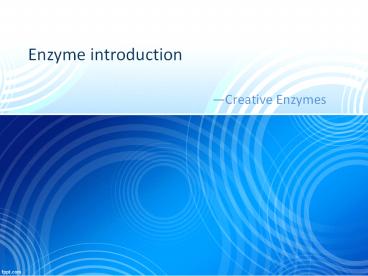Enzyme introduction - PowerPoint PPT Presentation
Title:
Enzyme introduction
Description:
. What are enzymes? How they work in biological reactions and living organisms? What are the applications of enzymes in biotechnology and medical research? Here, you can find what we have summarized. – PowerPoint PPT presentation
Number of Views:174
Title: Enzyme introduction
1
Enzyme introduction
- Creative Enzymes
2
- 5,000 years ago, people stored milk in animal
stomachs, in which milk can be turned into
cheese. Enzymes have been used in the diagnosis
of disease since the 1940's, derived from the
intensive research in biochemistry. What are
enzymes? How they work in biological reactions
and living organisms? What are the applications
of enzymes in biotechnology and medical research?
Here, you can find what we have summarized.
3
What Are Enzymes?
- The oldest recorded example to the commercial use
of enzymes may be found in a description of the
wine making practice in the Codex of Hammurabi
(ancient Babylon, circa 2100B.C.). Ancient people
already learned to use microorganisms as enzyme
sources in fermentation. This activity spread all
around the world, not limited to ancient Babylon,
but also known in the early civilizations of
Rome, Greece, Egypt, India, and China. Another
oldest use of the enzymes was for the dairy
products people stored fresh milk for any
reasonable length of time in multiple animal
stomachs, which contains enzymes called rennet
that can turn milk into cheese.
4
Enzymes Function
- Enzymes can be found all around us. They exist in
all forms of lives, including human, plants,
bacteria, and other organisms. Any living
organism needs enzymes to function properly.
Chemically, enzymes are naturally occurred
proteins, basic function of which is to speed up
the process and efficiency of a chemical reaction
without being consumed in the process. In another
word, an enzyme is a protein-based catalyst.
Enzymes catalyze all kinds of chemical reactions
that are involved in growth, blood coagulation,
healing, diseases, breathing, digestion,
reproduction, and many other biological
activities.
5
Enzymes in Medical Research
- In 1902, Emmerich observed that an extracellular
secretion of Bacillus pyocyaneus was capable of
killing anthrax bacilli and could protect mice
from the lethal bacterium. Not until that did
people realize the importance and applications of
enzymes in medical research. With the development
of enzymology, the global enzyme market sizes up
to USD 8.18 billion in 2015 and is expected to
reach USD 17.50 billion by 2024, according to a
new report by Grand View Research, Inc. Among all
enzyme products, enzymes for medical research are
expected to witness significant growth in the
following years and share an increasing
proportion of the market.
6
Enzymes in Biotechnology
- Biotechnology could be traced back to thousands
of years ago, when human started to use yeasts to
make liquor. This may be the first dawn of
biotechnology in food production. Along with the
development of natural and social sciences,
nowadays, biotechnology carries more colorfulmeani
ngs. - In the modern world, biotechnology often refers
to the process of making or modifying products
using living systems or organisms. Besides the
traditional fermentation, biotechnological
tools have expanded to employ more advanced
sciences, such as genetic engineering, applied
immunology, and medicinal therapies and
diagnostic. Among these tools, a variety of
enzymes are indispensablethey may appear
as hammers and chisels to help accomplish
molecular biology experiments, or they may act as
efficient micro-reactors in industrial
production. They exist everywhere and resemble
all kinds of functions in living cells or in
harsh environments bearing no life. As of today,
people exploit their functions in great details
for better uses in biotechnology.
7
- Thanks for watching!
- Contact Creative Enzymes
- Address 45-1 Ramsey Road Shirley, NY 11967, USA
- Website https//www.creative-enzymes.com

